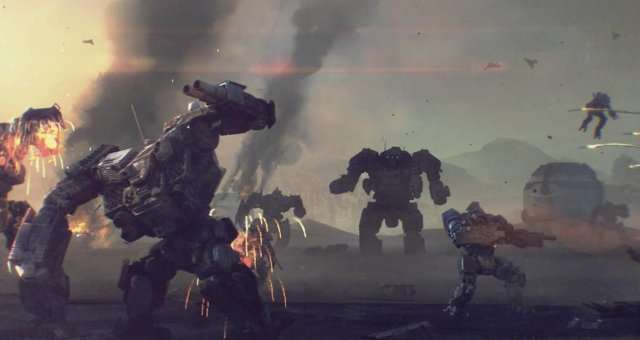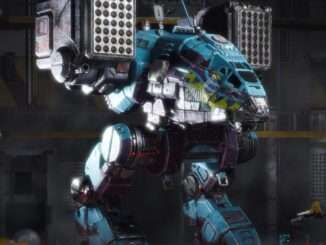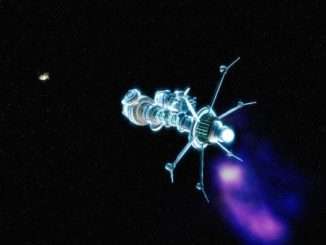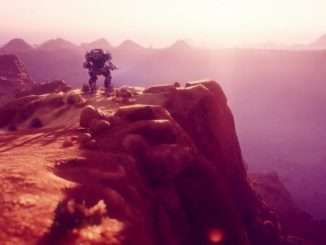
This guide is meant to be for journeymen players, people who have already gotten their feet wet and understand the mechanics of the game. This is meant to be a commentary on battlefield tactics for Battlemech combat.
Other BATTLETECH Guides:
- Beginners Guide (Combat Tactics, Pilot Skills, Contracts, The Argo).
- Understanding Hit Percentages and Accuracy.
- Mechwarrior Skills and Classes.
- Contract Enemy Guide.
- Mech Classification.
The Fundamentals of Battlemech Customization
All credit goes to Mechamorph!
One of the things most players twig on quite quickly is that stock mechs are pretty terrible. They tend to run very hot, be underarmoured and have a schizophrenic mix of weaponry. There are many measures of weapon performance in Battletech but in this video game they fall under three broad categories.
Firstly is stability damage. This mechanic is a game breaker as it allows even the most intimidating of mechs to be taken down by a lance of much lighter machines. Secondly is pure damage, hurting the enemy so that it blows up. Lastly is indirect damage, being able to shoot at a distant enemy who may be out of line of sight.
Weapons fall under two broad categories for how they deal damage as well. One are “sandblasters” like LRMs which throw small bits of damage over every hit location. The other are “slugs” which deal all their damage to a single location. Both have their uses and their roles.
A slug can easily deal a lot of damage to a single location, exposing internal structure to damage. Sandblasters excel at exploiting this since each instance of damage gives a chance for critical damage. Four medium lasers and one AC/20 may deal the same amount of damage but the lasers will spread it out while the autocannon will put it all in one place.
I will not overly debate the merits of the different weapon classes or individual weapon. This guide is about tactical combat, not statistics. When building a mech, keep in mind what role you want it to play and kit it out accordingly. Weapon types are less important than weapon synergy. Having compatible ranges means that you have a distance at which your mech excels and performs best. Mixing ranges overly much tends to degrade your performance as your weapons miss more often, dealing less damage.
For example the AC/20, medium laser and SRM all have the same optimum range. They work well together; the AC/20 will all but strip armour from a single hit location while the SRMs and medium lasers go hunting for criticals. Tacking on two different types of Autocannon will mean having to carry many loads of different ammunition and having one weapon or the other be unsuitable for the current range.
Practically all lances should have at least one mech that specializes in ladling out tonnes of stability damage all at once. Missile boats are very popular for this role, mechs that are mainly equipped with LRMs. Not only do they have plenty of range, able to kill enemies from a distance but they also guarantee the “unsteady” condition which takes away all evasion pips from a mech. All their lancemates should mount at least one weapon capable of dealing some stability damage as well. This is to capitalize on the Unsteady condition and cause a knockdown. A pack of SRMs or LRMs easily fill this role. Mainly because you have to actually knock down a mech after filling up its stability damage bar. Spill over from your missile boat will not help you here. Comms gear makes a good addition to these mechs since the extra Morale is pretty useful and they really should not be in the press of combat.
All lances should have at least one sniper mech capable of dealing direct damage over a long range. LRMs generally lack the punch to seriously damage mechs at any one location. This provides cover for your other mechs to close the distance and keeps the enemy honest when they engage you in a long range duel. They often also double as the lance’s scout and benefit greatly from viewfinders that increase their sight distance. This lets you shoot them before they can shoot you, puts your LRMs into service and lets you play keep away until the rest of the lance can close in.
Brawler mechs are mechs specialized in mid to close range combat. They tend to be your main damage dealers and should mount as much protection as you can manage since they will be engaging with the bulk of the enemy forces. Two of them should be adequate. The AI basically tries to grief you by madly focusing on one mech at the expense of tactical requirements or basic sanity. If you have cockpit mods, these mechs should be the first pick to install them in. If you can afford it, make at least one of these mechs jump capable. If fact making all of your mechs jump capable is not a bad idea at all. Jumping, especially in close range, lets you flank enemies and gives you crucial tactical flexibility. A solid mix of slugs and sandblasters is usually the way to go. Having only the former hurts so badly when you miss. Having only the former can leave you at the mercy of the RNG, taking forever to kill a single mech since damage is going everywhere but where you need it to.
Different mechs are built for different roles, even if that role is a sad joke of the universe like the Banshee or Charger (look it up, it is the biggest joke of battlemech design ever). They have different stock engines that give them their run speeds. It is crucial that your fastest mech does not outstrip your slowest mech by too much. If the lance gets strung out, they will be cut down piecemeal like Miyamoto Musashi’s famous gambit. Hardpoints determine what weapons you can slot in to which mech location. Torso locations are more heavily armoured and protected but weapons in the arms get a bonus to hit.
Always remember that Battletech in all its incarnations is subject to Diminishing Returns. An LRM 20 is heavier than two LRM 10s. Unless you are stuffing in a large number of weapons in a mech by minimizing its armour (why?!), you generally will have spare hardpoints. Putting in two LRM 15s and an LRM 10 instead of two LRM 20s will save you a couple of tons. Four LRM 10s save you even more. This makes mechs with a lot of hardpoints or a lot of a single kind of hardpoint (MISSILES!) very valuable. When in doubt, slot in a medium laser when you have a spare ton. It is an excellent auxillary weapon and well regarded for a reason.
Heat management is a concept not well understood by battlemech engineers. Mainly because the textbooks were probably written with double heat sinks in mind and so what if the mech shuts down during combat? Its just job security for the mech engineer since somebody must fix these obvious problems in mech design. When customizing your mechs, I would strongly recommend not going below a heat efficiency rating of 5. That would make you overheat after approximately three alpha strikes. It is better to sacrifice a large laser and add the weight in heat sinks if it means that you can safely alpha strike consistently with a decent number of weapons.
The Heat of Battle
Okay, now to the meat and drink of this guide. Combat in Battletech can be maddening. Mainly because the enemy often outnumbers you by a wide margin. Sometimes you can face as many as a short company of mechs at the same time. Regardless of your skill, you are not walking away with pristine mechs. Here are some basic tactical tips for the combat.
You can remove mechs from the battlefield in four ways; destroying the centre torso, disabling both legs, knocking out the pilot and destroying the cockpit in that order of difficulty.
To take out mechs quickly. Flanking is crucial. Damage transfers from the arm to the torso and then to the centre torso. Firing from the front spreads damage to eight hit locations (head, two arms, two legs, two side torsos and centre torso). Firing from the side only has three locations (arm, torso, leg). If you decided that disco is not dead in the Inner Sphere and built a mech with half a dozen medium lasers, shooting from the side will quickly kill a mech especially compared to shooting it from the front. Now shooting it from the back uses a whole different, and significantly smaller, amount of armour. Remember what I said about jump jets on brawlers? Yeah.
When using heavier mechs, putting a slug through the centre torso is usually an easy means of killing a mech on the spot. Not that many mechs can survive an AC/20 to the centre torso, let alone the two a King Crab mounts stock. Throw in some SRMs and a called shot to the centre torso can lay low even an Atlas. There are two ways of getting called shots. One is the Inspiration Ability Precision Shot. The other is to knock down the opposing mech with stability damage.
The latter is key to the other means of killing a mech (on purpose). Sure you might accidentally get a head shot but really how often can you do this consistently? Knock it down, pick a juicy location and shoot away. Why go through all that trouble? Salvage. Delicious, sweet salvage.
Most mechs do not mount anything good in the legs. So if you only hit the legs, you get all of the components as a choice. Later in the game this includes rare weapons and equipment. It also gives you two pieces of mech salvage from whatever you kill. Useful if you want more walking metal dolls action figures in your army. A Precision Shot to the leg by your heaviest hitter can do the trick while the other mechs take out the other leg.
Giving a mechwarrior a case of Shaken Baby Syndrome on steroids yields great rewards. It gives 3 pieces of mech salvage (ie the whole mech if you have enough choice slots) and if you do it right, it can give you the vast majority of components. If you have mechs all armed with stability damage weapons, fire just enough to knock it down. Do not alpha strike since very few mechs can survive this and will easily blow up due to damage in the centre torso. If you time it right, you can knock down a mech twice in a round. Other means of dealing injury is the destruction of a torso side, an ammo explosion and a hit to the head. LRMs to the face hurt even if it does not blow up the cockpit. Who would have guessed? Doing this can be risky; if you destroy a side torso, the excess damage transfers to the centre torso. Too many ammo explosions (ie the last injury comes from an ammo explosion) will blow up the mech as if you had destroyed the centre torso.
As for shooting it in the head…. often it is a happy accident. Without Called Shot Mastery, the odds are a pitiful 4%, with it you have a sunny 16% chance. Get ready to save and load often if you try. And given the loading speed of this game, you might as well just rock the mechwarrior’s world with LRMs if you want all the mech salvage. It will take less time.
Mechs that you prioritize for salvage depends on your playstyle. Personally I found the Panther, Vindicator and Centurion useful early game. Mid game the Orion and Thunderbolt are pretty solid. The assault mechs are pretty thin on the ground, the Awesome is fun if not impractical, the best of the lighter assaults are the Highlander and the Zeus. End game, put on your game face and hunt down some Atlases and King Crabs. The best all rounder among the assaults? The Stalker. Its the build-a-bear of mechs with plenty of hardpoints, enough weapon tonnage to make even an Atlas nervous and well protected enough to murder the hell out of (almost) anyone before they can kill you right back.
When training your pilots, you only get three special abilities. The developers were even helpful enough to make some of them totally worthless (hi Juggernaut!) making your choices even easier. The skills of note are Bulwark, Sensor Lock, Multitarget, Ace Pilot and Master Tactician.
Your scout/sniper is best served with Sensor Lock and Ace Pilot. The latter lets you take an action before moving. The ability to shoot/sensor lock and then run away is a life saver for a scout, letting them to run away and live another day. If your scout only has short ranged weapons, my question is what has this mechwarrior done to you that you have made that person a modern day Uriah? Scouts tend to be the lightest mech and the one most likely to be shot to pieces if the enemy catches up to them. Really, the equipment that increases sight distance is invaluable for that reason. Walk into sight, sensor lock for the missile boat and scoot. Or shoot it defiantly with your piddly, mostly useless large laser or AC/2 if you like. It is also the only build that benefits greatly from Evasive Movement which gives an extra free evasion pip when moving. Not as useful as the others but it is great for someone whose back may be facing the enemy often.
Bulwark gives you Guarded and Entrenched (ie all types of damage save for Heat are halved) if you do not move. This is great for mechs that you don’t expect to move much like your missile boat or your brawler. Heavier missile boats also benefit from Multitarget which lets you designate different targets in your front arc for your various weapons to target. It takes approximately 30-40 LRMs to fill an entire stability bar. If you are like me, you have a Highlander with four LRM 15s. Destabilize two mechs, knock both of them down with a Multitarget brawler and then kill at least one of them. Rinse, repeat. At the very least knockdown deals an injury to the mechwarrior, drops it down one initiative rung and causes an accuracy penalty when standing up. All in all, not a bad investment. Likewise a brawler can benefit from Multitarget. They tend to be carrying a lot of weapons, they can knock down a total of two mechs if you mounted to SRM packs or the like and they can remove one evasion pip from each mech in the front facing if you feel this serves your purposes (it should, often, at the starting rounds of combat).
Master Tactician is the gift that keeps on giving. It gives you +1 initiative. It lets your mech move at the same time as mechs one weight class lighter. This is so good that it overshadows everything else. Unless you have a plan for other abilities (like a Multitarget King Crab with Breaching Shot on its two AC/20s), always pick this ability. Being able to beat up on the assault mech with your assault mechs before the enemy can even move is worth all the C-bills in the Steiner treasury. In fact, you can use Vigilance to move even earlier if you positively, absolutely need something dead right now.
Quality of Life Notes
Some small things that might make your life better.
Having too many save files can cause your game to slow to a crawl. Deleting them also takes an excruciatingly long time. You can find all save files at the (default) location of ..Steam/Userdata/[Steam ID]/637090/remote/C0 (or whatever number campaign it is) /SGS1/.
Just move and delete your files to make the game run smoother if it is starting to chug due to having too many saves.
From what I can observe, the mechs are randomized when you click the “begin mission” button. The mech classes tend to be fixed but which mechs appear are to some extent random. The number of Skulls are reflective of total weight of the opposition, money offered as a reward is a good idea of the overall difficulty of the mission. After all fighting five 20 ton mechs is not the same as fighting one 100 ton mech. Some missions only have a lance of mechs in the opfor. If you are hunting for a certain assault mech, you can keep reloading the mission to before you launch (helpfully the game autosaves then) to keep rolling for the mech you want. Any mission that involves a mention of reinforcements is unlikely to feature assault mechs until 5 skull difficulty or so while a 3.5 skull mission might feature an assault if a single lance are in the opfor.
When fighting heavy vehicles, do not use your missile boat or any mech whose main punch comes from sandblasting. Vehicles like the Demolisher and Shrek PPC Carrier have their armour concentrated in five locations (front, rear, two sides and turret) as opposed to a mech’s eleven (eight front locations, three pitifully thin back locations). This means that they generally pack more armour per location than some assault mechs. Sandblasting is simply not going to get you anywhere fast and you risk an AC/20 round to the noggin. Use your brawlers or invest in a called shot to one location.





Be the first to comment